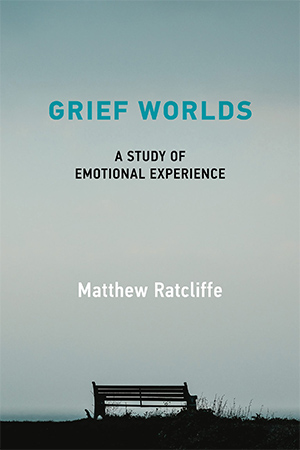Grief Worlds: In Conversation With Philosopher Matthew Ratcliffe

Experiences of grief can be bewildering, disorientating, and isolating — everything seems somehow different, in ways that are difficult to comprehend and describe. Why does the world as a whole look distant, strange, and unfamiliar? How can we know that someone is dead, while at the same time find this utterly unfathomable, impossible?

In his book “Grief Worlds,” philosopher Matthew Ratcliffe explores a host of philosophical questions raised by grief, showing how philosophical inquiry can enhance our understanding of grief and vice versa. Throughout the book, which is available in a free open-access edition, Ratcliffe focuses on the phenomenology of grief: What do experiences of grief consist of, how are they structured, and what can they tell us about the nature of human experience more generally?
To get to the bottom of these questions, Ratcliffe co-led a four-year project at the University of York, where he and a small group of researchers investigated people’s experiences of grief, focusing especially on aspects that are poorly understood, puzzling, and difficult to articulate. (A rich and searchable corpus of the responses to a survey of grief experiences that they conducted has been made available to the public.) We asked Ratcliffe about his research, the project’s findings, and his new book.
You’re currently heading up a four-year project at the University of York focused on grief. What drew you to the topic, and how did this project originate?
I was drawn to the topic of grief from a number of different directions. Back in 2008, I published a book entitled “Feelings of Being” (Oxford University Press), which addressed an aspect of our emotional life that I called “existential feeling” — a pervasive sense of reality and belonging to the world. This aspect of experience, I suggested, is susceptible to a range of different alterations and disturbances, as exemplified by forms of experience associated with various psychiatric diagnoses.
I contrasted existential feelings with episodic emotions and also with certain, more superficial moods. However, I was aware at the time that I had not succeeded in accommodating grief, which is a temporally extended emotional process, rather than a brief episode, a mood, or an existential feeling. Nevertheless, grief can involve quite profound alterations in the sense of reality and belonging. So, the task remained of clarifying how it relates to — and plausibly incorporates — existential feeling.
I went on to investigate the phenomenology of depression, which led me to address the question of whether and how experiences of depression might be distinguished from both typical and supposedly pathological forms of grief. Later, I did some work on hallucinations, including so-called “bereavement hallucinations.”
In light of all this, I found myself increasingly drawn to the topic of grief. Hence, shortly after joining the Philosophy Department at York in September 2018, my departmental colleague, Louise Richardson, and I submitted a research grant application to the UK Arts and Humanities Research Council, setting out the four-year project on the phenomenology of grief that you mentioned.
I want to get back to that project, but first, can you say a bit more about bereavement hallucinations? There’s a fascinating chapter in the book where you explore this phenomenon — the general sense or feeling of someone’s presence after they’ve died.
A hallucination tends to be thought of as an experience that resembles a genuine perception but arises in the absence of the relevant object. Given this, we might think of “bereavement hallucination” as matter of it looking just like someone is really there, when they are in fact not. However, a problem with labeling sensed presence experiences “hallucinations” and thinking of them in these terms is that it fails to acknowledge the many ways in which such experiences can be important to those who have them — how they are interpreted and integrated into people’s lives.
Another problem is that many sensed presence experiences do not in fact conform to orthodox conceptions of hallucination. Granted, some do seem to involve experiencing a person as physically present in a particular location, through perceptual modalities such as vision, audition, or touch. Other experiences, though, involve a more diffuse sense of presence, which doesn’t always incorporate specific perceptual qualities. Sometimes, it “feels” as though the person is there, but not because we see them in a certain place, feel their touch, or hear their voice.
In the book I offer an analysis of such experiences, according to which they involve being affected in a way that is characteristic of being with a particular person. What I have in mind here is also familiar to us during the course of everyday life. Take the experience of walking along a beach or through a park with someone you love. In a way that is difficult to pin down to anything in particular — you experience and relate to your surroundings in a way that differs from how you would when alone or with someone you feel awkward with.
Many sensed presence experiences involve something like this. To feel the “presence” of someone is not just to experience them as located nearby but to feel connected to them, to experience things in a distinctive way that is inseparable from being with them. This can be understood in terms of how they shape and reshape the significant possibilities offered by one’s surroundings in a dynamic, ongoing manner.
Things can thus look different, depending on who one is with. So we need to be careful with the term “presence” — the experience is often one of connection and relatedness, not mere physical presence. The point applies more generally to experiences of distinctively personal presence; to be with someone is to be affected by them, in ways that might be unique to that person. Such experiences can be quite pronounced but are often more subtle.
It can be added that this sense of relatedness admits considerable variety. Rather than thinking of it in terms of “hallucination,” I have suggested that a better place to start is the growing literature on how we retain “continuing bonds” with those who have died. Often, what might be interpreted in terms of hallucination is instead a diffuse sense of connection. And this is not a simple matter of taking someone to be there when they are in fact not.
What are a few other specific aspects of grief that are poorly understood?
One puzzling feature of grief is its temporally extended structure. There is the question of what, if anything, unifies a grief process and holds all of its various constituents together. How does it differ from a disparate string of separate emotional experiences spread over time? My answer, in brief, is that grief involves recognizing, understanding, engaging with, and adapting to a profound disturbance in the structure of one’s life, something that can also be described in terms of changes in one’s experiential world. In the second chapter of “Grief Worlds,” I propose that grief is unified to the extent that this phenomenological disturbance is unified.
However, many other aspects of grief are also poorly understood, in ways that raise interesting philosophical issues. For instance, in my book I discuss at length the manner in which grief can involve knowing full well that someone is dead and yet, at the same time, finding it somehow impossible, unfathomable. Among other things, this raises broader questions about what it is to believe something. In one sense, we fully believe that someone is dead: We explicitly acknowledge that they are dead, we have no doubt about this, and — to a large extent — we act accordingly. But, at the same time, it all seems somehow wrong, unbelievable, even unreal.
To make sense of this, I develop an account of how we can assent to the proposition “they are dead” but do so against the backdrop of an experiential world that continues to imply the person’s presence in all sorts of ways. To be more specific, the significant possibilities inherent in our surroundings still point to that person — this is their room; these are their shoes in the doorway, waiting to be worn; this is the sofa where we sit in the evenings. Despite our explicit belief to the contrary, what remains largely intact — at least for a time — is a vast system of interconnected habitual expectations that is integral to our experiential world. This world continues to operate as a backdrop to our more localized experiences of entities, events, and situations, as well as our activities and patterns of thought. A grief process involves, at least in part, coming to reconcile the structure of our world with the fact of the death.
Those are just some of the ways in which grief is philosophically intriguing. In the book, I also address themes such as the relationship between emotional experience and linguistic thought in grief, how grief can involve a breakdown of previously taken-for-granted norms and thus a pervasive experience of being lost, how interpersonal and social processes contribute to the unfolding of emotional experiences over time, how experiences of grief over the death of a person resemble and differ from various other emotional experiences of “loss,” and the manner in which grief is painful.
Many first-person accounts of bereavement state that it is somehow like losing a part of oneself — some even make specific comparisons between bereavement and losing a limb. In the book, you write that there’s more to this than metaphor, that the two experiences are structurally similar in specific and philosophically informative ways. How so?
That’s right. I think the two experiences are — or, at least, can be — similar in important ways. I further maintain that our bodies and our interpersonal relationships contribute to the structure of experience in ways that are inextricable. In the book, I take my lead from Merleau-Ponty’s brief discussion of grief and phantom limbs in his 1945 book “Phenomenology of Perception.” He suggests that the possibilities we experience as inherent in our surroundings reflect, among other things, our bodily capacities. That the stairs appear climbable, the glass of water as something to be picked up, the keyboard as something to type with — all such possibilities imply the possession of a more or less specific set of bodily abilities.
According to Merleau-Ponty, the experience of a phantom limb is not localized or image-like. Instead, it is constituted by the retention of experienced possibilities and, more specifically, patterns of habitual expectation that imply the capacities of an intact limb. Although one might see that the arm is gone and also know full well that it is gone, one’s surroundings as a whole continue to offer various possibilities, which together comprise a sense of the arm’s enduring presence.
Merleau-Ponty suggests that something very similar applies in the case of bereavement. You assent to the proposition “the person is dead” and yet continue to experience all of those possibilities that depend upon them and point to their potential presence. So, you know full well that they are gone while expecting them to walk through the door at any moment.
I do not simply endorse Merleau-Ponty’s view. In fact, I emphasize that phantom limb experiences are quite diverse and also that many of them do involve image-like phenomena. But I add that the same can be said in the context of bereavement. As well as having a diffuse sense of continuing presence, one can have more localized, image-like experiences of the person who has died.
I add that other people and our own bodies contribute to the significance of our surroundings in ways that are often indissociable. For instance, pursuing a project (in the context of which things appear significant in various ways) may depend upon being able to act upon the world in a certain bodily way, while at the same time requiring or presupposing a particular person — it might be something that I can only do with them, or something that I do for them.
So we can see why people so often describe bereavement as like losing part of oneself, undergoing an amputation, or losing a limb. Another person can be integral to the orientation through which we encounter our surroundings, think, and act, just like our own bodies.
Coming back to the project at York and the qualitative survey of grief experiences, on which you draw throughout the book. Were there any findings that surprised you and your group?
Yes, there were. The study was explicitly concerned with grief over the death of a person. However, it came to the attention of members of “Gateway Women”, a support group for involuntarily childless women. As a result, 29 of our 265 participants instead described experiencing grief over childlessness. Their responses also mentioned a variety of more specific circumstances. However, in all cases, the principal object of their grief was childlessness per se, rather than a more concrete loss involving specific past events.
We found these testimonies informative in two principal ways. First of all, they prompted us to explore more encompassing conceptions of “grief” or “loss.” Up to that point, our work had focused almost entirely on bereavement. Second, in describing an emotional experience of loss concerning what never was and never will be, some of these respondents indicated that their grief related to lost possibilities. These possibilities were integral to who they are or who they once were, to a kind of identity (which corresponds roughly to what the philosopher Christine Korsgaard has called “practical identity”). This contributed towards our developing the view that grief, more generally, is centrally a matter of recognizing, understanding, and engaging with losses of possibility.
Something else that we did not anticipate was the COVID-19 pandemic, and the radical social restrictions that came with it. The majority of our respondents were based in the UK, and the survey was disseminated at a time when the UK was under lockdown. Furthermore, social restrictions of various kinds were in place throughout the time it remained open. It would be incorrect to say that we were “surprised” to find that many of the participants mentioned social restrictions and their impact on grief. That said, when the project started in January 2020, we had no idea that we would be conducting our research in such extraordinary circumstances. First-person accounts of the effects of pandemic restrictions, obtained through this study and also other sources, prompted us to reflect both on the ways in which grief is regulated by interpersonal, social, and cultural environments, and on how grief over a person’s death might be altered when it occurs amidst a wider-ranging sense of loss and disorientation.
You argue that it is a mistake to think of personal loss in terms of the subtraction of something concrete from one’s world. You write: “Instead, the experience of loss consists primarily in a sense of certain possibilities having been extinguished: one’s own, those of the deceased, and others that were shared. The object of grief is not simply a death, the fact that someone is dead, or the loss of a valued relationship. It is a loss of life possibilities, something that is compatible with other, more concrete descriptions of grief’s object.” Can you say more about that?
Yes, I maintain that the object of grief, what it is about or directed at, is a loss of possibilities. This applies to bereavement and also to emotional experiences of “grief” or “loss” in a range of other circumstances.
It is commonplace in philosophical discussions of emotion to distinguish between the concrete and formal objects of an emotion. For instance, while the concrete object of fear might be a fast-approaching and hungry tiger, the formal object is threat. However, where grief is concerned, I suggest instead that the object(s) of grief are experienced with varying degrees of concreteness and also that the emphasis varies at different points during the grief project — at a particular time, one’s grief might be preoccupied primarily with the way in which a person died, the fact that they are dead, the loss of a relationship, what the future now holds, or various other considerations. What makes something an object of grief is its being integral to a wider-ranging loss of possibilities. Furthermore, it is experienced as such. Hence, I would not deny that grief is about a death or someone’s being dead, but I would add what we grieve over is the death as a loss of possibilities.
Of course, we lose possibilities all the time. Furthermore, even losing possibilities in which we were heavily invested need not add up to grief. However, drawing on a number of different sources, I argue that what makes a loss of possibilities an object of grief, rather than just, say, disappointment or regret, is that those possibilities were integral to one’s life structure, practical identity, or experiential world.
This is not to insist that grief is future-oriented, as opposed to being past-oriented. To lose important future possibilities is equally to change how we relate to our past. The significance of past events and the relations between them depend on what they led to and, with this, how they relate to the ongoing course of one’s life. Thus, memories of a wonderful day with one’s partner can be transformed by their death — those events no longer have the significance they once had or occupy the same place in one’s life.
One of the things that led me to emphasize the loss of possibilities, rather than a more specific, concrete object of grief, was the example of grief over childlessness. Where grief is directed at childlessness per se rather than its more specific circumstances, there is no historical, concrete object to be identified; there is only the loss of possibilities around which one’s life was once structured.
It is tempting to object that bereavement grief is altogether different in this regard. However, I reject that view. Consider the example of loving a child, who was once a baby and is now a young adult. The adult whom one loves has few, if any, significant properties in common with the baby, and the relationship has also changed radically. Yet we do not tend to grieve over all that is consigned to the past, at least where the journey to adulthood is largely one of positive development — of actualizing possibilities rather than having them negated. Where so much has already receded in the past, the person’s death does not make it any more past, any more lost.
When we pursue this kind of thinking to its conclusion, we come to see that it makes little sense to regard losses as primarily historical. Rather, what is lost is a certain, distinctive configuration of possibilities or potentialities, something that the changing significance of past events equally depends upon. Not all bereavements are alike, and the emphasis can vary. Sometimes, what is most salient is my loss of possibilities, sometimes yours, and sometimes ours.
This emphasis on lost possibilities can accommodate a great deal of variety. It also enables us to understand how one’s world as a whole is transformed during grief and how it changes over time. Grief, I have suggested, is a temporally extended process that involves recognizing, comprehending, practically engaging with, and — to varying degrees — adapting to losses of possibilities that are integral to who we are and how we find ourselves in the world.
Matthew Ratcliffe is Professor of Philosophy at the University of York, UK. He is the author of several books, most recently “Grief Worlds: A Study of Emotional Experience.”

